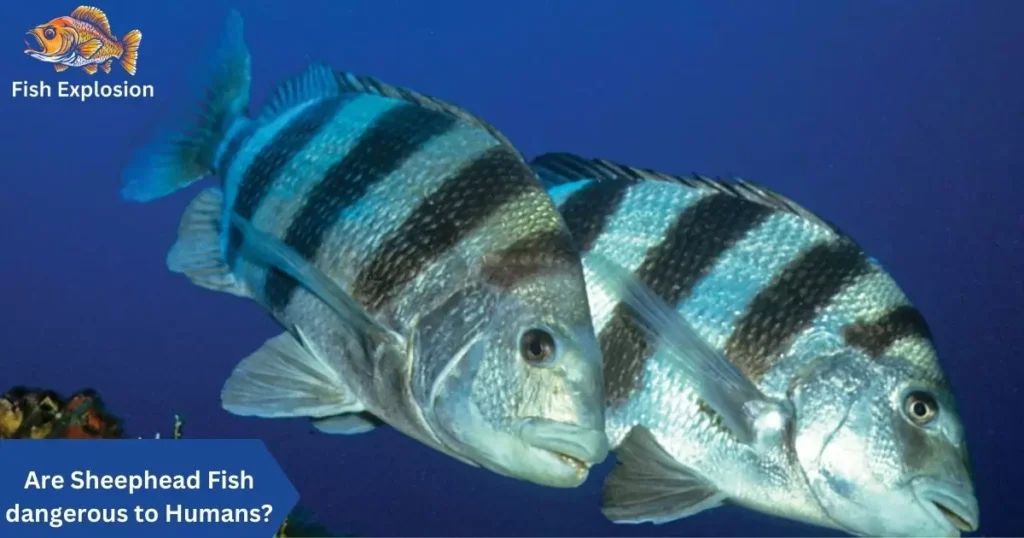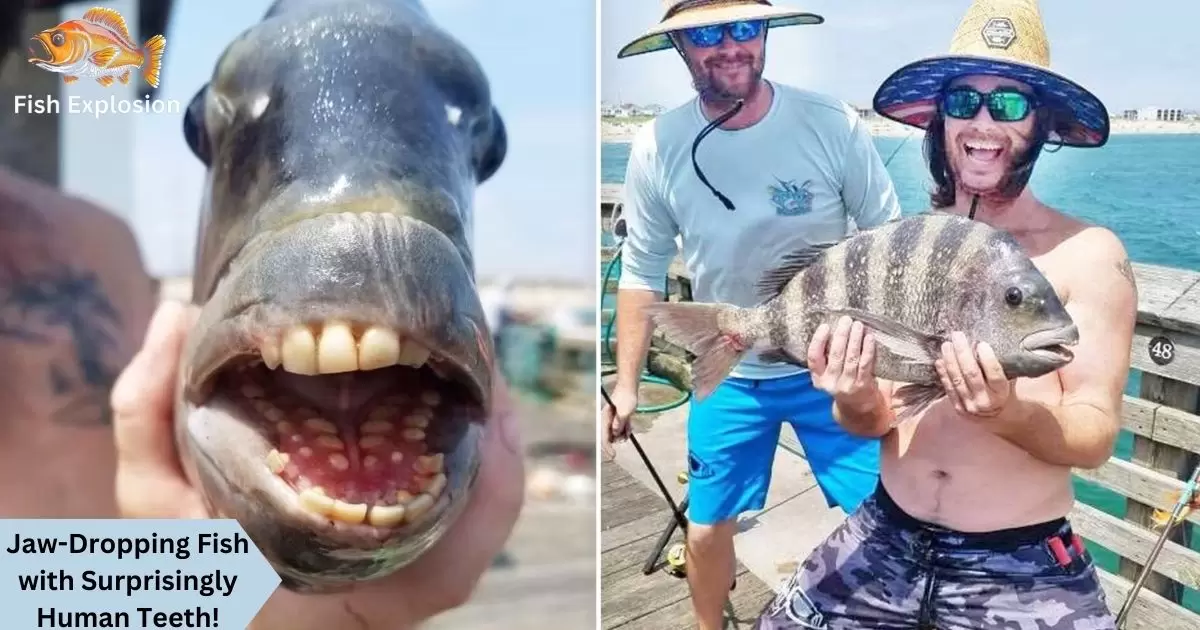There is a species of fish known as the sheepshead fish that has gained attention for its remarkably human-like teeth. These striped black and white fish found in coastal waters have a very unique set of teeth that amazingly resemble human teeth – complete with distinct molars, incisors, and grinding tooth structures. Their teeth are adapted for crushing hard-shelled prey like clams, oysters, and crabs. While their human-tooth appearance may seem unsettling at first glance, it actually highlights the incredible diversity and evolutionary adaptations present in the marine world. The sheepshead’s dentition allows it to thrive by taking advantage of prey that other fish cannot effectively consume.
Physical Description
The sheepshead fish (Archosargus probatocephalus) is a coastal marine species known for its striking black and white striped body coloration. However, its most remarkable physical characteristic is its jaw, which is full of teeth that bear an uncanny resemblance to human teeth.
The sheepshead has distinct molars at the back of its mouth used for grinding and crushing. Towards the front, it possesses incisor-like teeth capable of neatly shearing through food.
Complementing these are flattened grinding teeth on the top and bottom that work together like human molars when the fish bites down. This specialized dentition, highly unusual for a fish, allows the sheepshead to feed on hard-shelled prey like clams, oysters, and crabs.
Read More: “How Do Fish Breathe? The Science Behind Gills”
Habitat and Diet
The sheepshead fish makes its home in the coastal waters of the western Atlantic Ocean and Gulf of Mexico. It can be found near shorelines, oyster beds, jetties, and other shallow to moderately deep marine environments.
This fish’s unique set of human-like teeth has evolved to allow it to thrive on a diet composed largely of hard-shelled prey. Using its powerful biting and grinding abilities, the sheepshead feeds on clams buried in the sea floor, clusters of sedentary oysters, as well as crabs and other crustaceans.
Their ability to easily crack open these shelled organisms gives sheepshead access to a food source that few other fish can effectively consume.
Evolutionary Adaptation
The highly specialized dentition of the sheepshead fish is a prime example of evolutionary adaptation. Over millennia, the jaw structure and teeth of this species gradually transformed to allow efficient crushing and grinding of hard-shelled prey items.
This dietary strategy provided the sheepshead access to an untapped food source that other fish were ill-equipped to consume. With its humanlike molars, incisors, and grinding plates, the sheepshead can easily break through the tough exteriors of clams, oysters, crabs and other shelled organisms.
This unique evolutionary pathway highlights the incredible diversity present in the marine environment. As ecosystems changed over time, species like the sheepshead evolved specialized traits to take advantage of available food sources and reduce competition – a process that ultimately led to its jaw-dropping dentition.
Are Sheephead Fish dangerous to Humans?

While the sheepshead fish’s human-like teeth may look intimidating, these marine creatures do not pose any particular danger to people. Sheepshead are relatively docile fish that tend to avoid human interaction, and injury incidents are extremely rare.
Their teeth, while certainly capable of delivering a painful bite, are designed for crushing shelled prey rather than tearing flesh. Unless drastically provoked or accidentally stepped on, sheepshead have no innate drive to bite humans.
From a dietary standpoint, their mouth, loaded with grinding plates and molars, is also ill-suited for any sort of dedicated human bite compared to the teeth of larger predatory fish.
So while their chompers may be jarring in appearance, sheepshead fish’s unique dental architecture is an evolutionary adaptation for consuming their preferred diet of bivalves rather than a threat to beachgoers.
How do Sheephead Fish breed?
Sheepshead fish engage in a fascinating breeding process characterized by spawning, where females release eggs and males fertilize them externally in the water. This usually occurs in coastal areas, estuaries, or near the mouths of rivers, providing a safe and nutrient-rich environment for the eggs.
The spawning season typically spans from late winter to early spring, when water temperatures start to rise, which is crucial for the development of the eggs.
Sheepshead fish reach sexual maturity at around two to three years of age, and their spawning activity is highly influenced by the lunar cycle, with peaks in activity around the full and new moons.
This reproductive strategy helps maximize the chances of survival for the offspring by dispersing the eggs over a wide area, reducing the risk of predation and increasing genetic diversity among the population.
Why do Pacu Fish have human teeth?

- Evolutionary adaptation for a vegetarian diet.
- Their human-like teeth are well-suited for grinding and crushing vegetation, fruits, nuts and seeds.
- These teeth bear a strong resemblance to human molars and incisors.
- It allows them to consume a wider variety of plant matter compared to fish with typical sharp teeth.
What is a Jaw Fish?
The jawfish, also known as the shrimp fish or bullseye bellowsfish, is a unique marine species found in the Indian and Pacific Oceans. These small fish get their name from their large, protruding jaws, which they can extend outward to swiftly catch prey like shrimp and other crustaceans.
When threatened, jaw fish can make a drumming sound by contracting their bladder muscles rapidly. Perhaps their most distinctive feature is the bullseye-like black marking around their eyes, which gives them an almost cartoonish appearance.
FAQ’s
Is the fish with human teeth real or fake?
The fish with human-like teeth is real.
What is the name of the fish that has human teeth?
The name of the fish that has human-like teeth is the Pacu.
What is an aggressive fish with human teeth?
An aggressive fish with human-like teeth is the Sheepshead fish.
What is the Brazilian fish with human teeth?
The Brazilian fish with human-like teeth is also the Pacu, known for its surprisingly human-like dentition.
Conclusion
The sheepshead fish, notable for its striking dentition resembling human teeth, serves as a testament to the marvels of evolutionary adaptation within marine ecosystems. Residing in the coastal waters of the western Atlantic Ocean and Gulf of Mexico, this species has evolved a unique set of molars, incisors, and grinding plates.
This specialized dentition allows it to crack open hard-shelled prey like clams, oysters, and crabs, accessing a niche food source. Contrary to their formidable appearance, sheepshead fish are harmless to humans, with their teeth adapted more for crushing shells than inflicting harm.
Their breeding strategy, involving external fertilization, is fine-tuned to their habitat, ensuring the wide dispersal of eggs and maximizing offspring survival. This fascinating evolutionary journey underscores the adaptability and diversity of life in marine environments, highlighting the intricate balance of ecosystems where each species plays a crucial role in maintaining ecological harmony.
With three years of dedicated expertise in the niche of fish, my domain knowledge encompasses breeding, habitat maintenance, health management, and sustainable aquaculture practices, ensuring optimal outcomes in the aquatic realm.











